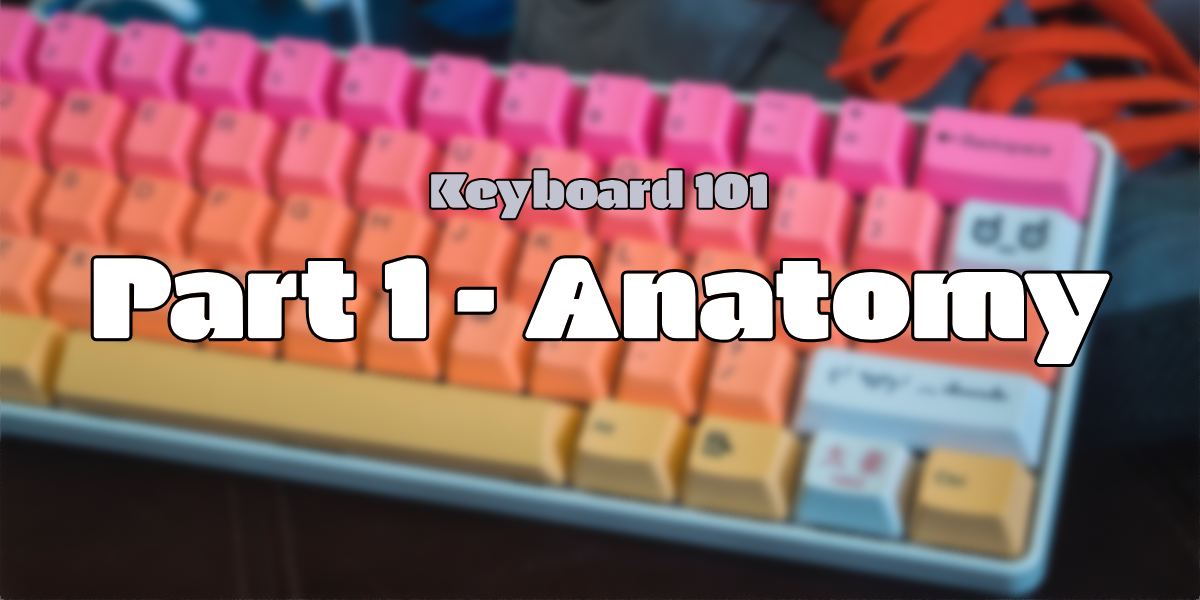Keyboard 101 - Part 1: Anatomy

Keyboards, tools of you daily life. Everybody has some (one, or more 😇) but do you know what’s inside ? From layouts to profiles, from membrane keyboards to mechanical ones, let’s dive together in this wonderful world.
I could have told you about laser keyboards or virtual keyboards, but the truth is, anything that output an electric signal can be a keyboard. So, for now, let’s stick to the more “classical” keyboards, with hardware, the most commonly used.
In order to not knock you out right now, let’s go step by step by beginning with keyboard anatomy. There’s so much to say, it’s better to have multiple parts! 😅
Pieces⌗
Every keyboard, wether it’s mechanical or membrane, are made of the following elements:
- a set of actuators, the membrane or the switches depending on the type of the keyboard, they transform physical action into an electrical signal.
- a controller, whose role is to transform the signal into a “symbol” directly sent to the computer. (ie
line 4column 2==A) - A Printed Circuit Board (PCB), which link actuators to the controller
- a case, which dresses up the keyboard, protects its internal components, and gives structure to the whole (we do not want a keyboard that bounce at each keystroke!)
- the keycaps, obviously, which protect the actuators, but more importantly give its personality to the keyboard
How it works⌗
A keyboard, in the first place, is a set of switches. Pushed, the power is on, released the power is off. That’s how the controller (its brain) translate the position of the active switch into a letter. To do so, originally, a keyboard was a grid of verticals and horizontals wires:
Pushing a key activate a vertical wire and an horizontal wire, to recognize the “position” of the active switch. The controller only had rows * columns to manage.
The downside of this operation was that when reaching a certain amount of pushed keys, the controller was no longer able to detect a new key. That what is called “ghosting”.
Hopefully, nowadays ghosting is increasingly scarce because controller are more and more miniaturized and can manage as many inputs as necessary. We now talk of NKRO keyboards (n keys roll over) which, by design, cannot ghost any keystroke.
Keyboard families⌗

There is roughly 2 major types of keyboards, that I’m talking about from the beginning now: membrane keyboards and mechanical keyboards. Historically, all keyboards were mechanical. But technological advances have made the rise of the membrane keyboards possible, relegating the former to the rank of “gamer” keyboards, even if they are worth much more than just that.
Membrane keyboard⌗
The most common and cheapest keyboards on the market. The principle is straightforward. A membrane is made of 3 layers: the contact, the middle, and the active layer. The middle layer has openings, to allow contact between the two outer layers at the hole in each key.
They are very silent, because the plastic membrane deforms “smoothly”, however when aging the membrane can become softer, which leads to keys not being registered, or keys that won’t come up after the keystroke… And if the membrane breaks somewhere, you can ditch the whole keyboard and get a new one. Easy to produce, they are mainly made of plastics. So they are fairly light, come in a wide variety of forms, they can be flexible… If you don’t know what’s your keyboard type, chances are you have a membrane one (because for mechanical ones, being mechanical is a selling point 😛)
| Pros | Cons |
|---|---|
| ✅ Cheap | ❌ not very lasting |
| ✅ Silent | ❌ Low Typing comfort |
| ✅ Somehow thin |
Mechanical keyboard⌗
Mechanical keyboard are called that way because of their actuators: the switches. They are actual switches, mechanically activated when the key is pushed down. A whole new and fascinating world that we will dive in another time!
To hold theses switches, such keyboards need a switch plate, a metal plate that comes to stabilize switches in place. That means that mechanical keyboard are often heavier, but much more stable, and if a switch break… Just change it!

Moreover, most of the switches are standardized. The leading brand, Cherry MX, set the pace of this industry, and you will often find “cherry clones”, meaning that they follow the same specs. Each switch category will change the typing experience, allowing each and every one of us to find the confort that match one taste.
| Pros | Cons |
|---|---|
| ✅ High durability | ❌ Costly (compared to membrane) |
| ✅ Reparable | ❌ Louder (rumor has it 😜) |
| ✅ Customizable |
Ok, that’s a start! Now you know what you have at your fingertips. In the next part, we will discuss about the different forms keyboards can take, and believe me there’s something for everyone! ⌨️
Ressources⌗
To go further, here’s a list of articles that helped me writing this one
- Anatomy of a mechanical keyboard by Isabela Moreira
- What Is a Membrane Keyboard, and Is a Mechanical One Better? by Georgie Peru
- What’s NKRO from Open Steno Project
- What is keyboard ghosting ? by Mech Keybs